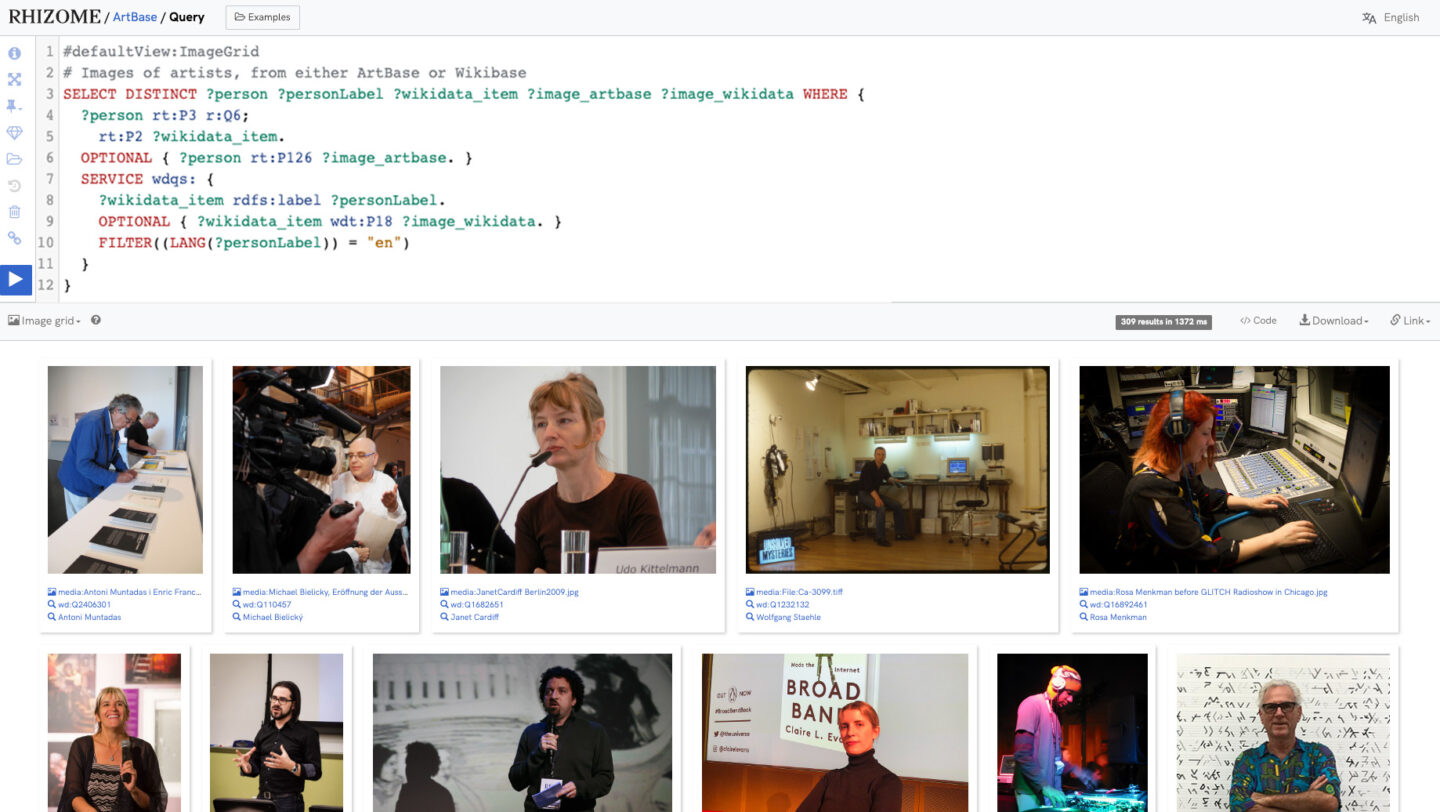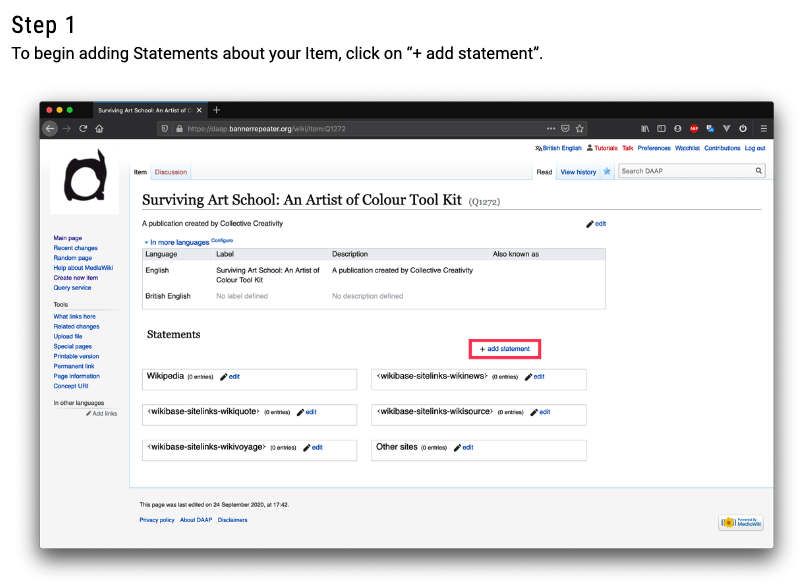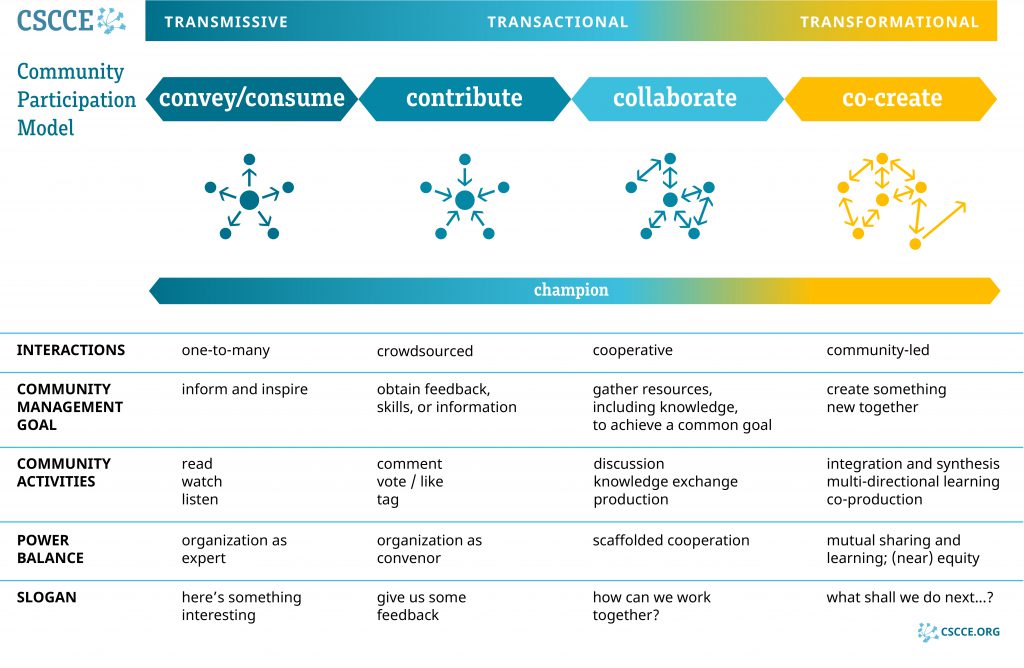Championing new methods
Valerie Wollinger

Interview with Dr. Lozana Rossenova by Valerie Wollinger
Some months ago, I started this blog series with the intent to tell the stories of community members and their use of Wikibase. For this article, I invited Dr. Lozana Rossenova (she/her) to talk about her journey with our software. Lozana is one of our longest-standing users and Wikibase advocates. A mainstay for many years, she experienced her first touchpoints through her Ph.D. that she did in collaboration with the arts organization Rhizome.
Lozana is a digital humanities researcher and designer. As part of her research, she redesigned Rhizome’s ArtBase, an archive of born-digital artworks from 1983 to the present. Today, she’s a post-doctoral researcher and Wikibase specialist in the Open Science Lab at TIB – Leibniz information Center for Science and Technology, Hannover. As part of that role, she’s also co-leading the Wikibase Stakeholder Group with her former Rhizome colleague, Dragan Espenschied.
First encounters with Wikibase
In the first part of our conversation, I wanted to know how it all began. How did Lozana meet Wikibase for the first time, and what happened after that?
Lozana: ‘My journey with Wikibase begins in 2016. At that time, I had been working in the digital design industry for a couple of years – in the field of digital archives, mostly in the educational, nonprofit sector. I was coming across the problem that while working in private companies, we were always building one-off products that were expensive and hard to maintain.’
Lozana told me that these initiatives were often not able to maintain their custom-built solutions in the long term. With that in mind, she started looking for alternative solutions. Around the same time, she had the opportunity to apply for a Ph.D. research position with London South Bank University at their Center for the Study of the Networked Image. The Ph.D. was framed as a collaboration with Rhizome and its international team, who were also working at the intersection of preservation and digital culture.
The aim was to redesign their archive of net art, says Lozana. ’Net art, to explain very briefly, is digital art that is primarily interested in the workings of the internet. So it may live on the web or off the web, but it’s generally not simply a digitized painting, for example.
‘It was a very interesting project… We were interested in long-term preservation and sustainability. At the same time, we were working with material that was very newly classified as culture.’
‘You wouldn’t see museums necessarily having a lot of these types of artworks in their collections. So there were no metadata standards, there were no best practices established by other institutions that we could look at. We had to come up with a lot of new methods and practices. And of course, Rhizome had been doing that for 20 years. So I was joining an already fully functioning organization. They had already been looking at different options to structure the archive, and they had chosen Wikibase.’
Lozana told me that when they first installed a very early release of Wikibase, they were mostly experimenting with its functionalities and exploring its flexibility. She added: ‘I was immediately very excited by the fact that we had a graphical interface over a knowledge graph, which was something unusual, especially at the time, and by the fact that we didn’t need a standard ontology to begin with.’ She added that this flexibility enabled them to add large amounts of diverse, complex information. Unlike other, more traditional art archives, they were working with unique information that needed properties and classifications that might only be used once.
This allowed her and the team to come up with novel categories that reflect contemporary digital art in a way that adapts to a fluid cultural landscape.
Lozana: ‘Since then, I have been advocating that Wikibase is a very appropriate system for contemporary art… It’s very hard to standardize artworks. Wikibase, I think, provides this flexible environment. It is a complex system – it’s not so easy to get familiar with the interface. But once you do, you don’t really need to be a data science expert to use it. So curators and art historians can also use it, and that was also an important consideration in the Rhizome project.’
Lozana looked at the software from an interface-theory perspective, observing that the complexity of the interface could also be ‘beneficial… there was an interface that people could learn to use, but it wasn’t what people would call transparent.’ In comparison to other commercial software, the wiki interface ‘wants its users to learn its capacity’, so they become better informed about the workings of the system behind it – which makes it a great tool to enhance users’ digital literacy.
Lozana: ‘What we’re talking about is people actually working with their data in an informed way. They understand what the data is doing, they understand who is doing what to the data, and they also understand how they can relate the data, which is something you don’t get so much in a traditional database, where the relationships are typically hidden, and you just get empty fields, and you have to punch some stuff in.’
It is that manual work of relating data which Lozana describes as an opportunity to take advantage of Wikibase’s flexibility in comparison to, for example, traditional library catalogs, where it is difficult to make perfect classifications of anything. She adds: ‘Things are not standard by default. Even books sometimes. That was really my first big impression of Wikibase and the possibilities there: the flexibility of the data modeling, the idea that there is an interface which can actually teach people digital literacy once they are onboarded on it properly. And ultimately, of course, we did want to connect to the Semantic Web.’
Lozana told me that because the collection of Rhizome included some traditionally less well-known artists, it wasn’t so simple to just link everyone to their respective catalog entries in something like the Getty’s Union List of Artists’ Names (ULAN), a big directory of artists. However, they could still connect some basic information about institutions via Wikidata. They were able to create some showcase federated queries between their Wikibase and Wikidata. She remembered: ‘That was a nice way to show that we don’t have to be a silo anymore. We can actually extend beyond our collection. And as soon as the rest of the world also catches up and starts using Linked Open Data more, then we can have even more sophisticated federation.’

View of the results of a federated query depicting artists who are also listed in Rhizome’s ArtBase and Wikidata, including images from both databases. CC-BY Lozana Rossenova.
The ArtBase was Lozana’s first Wikibase project. Before that, she had never heard of the software; it was still a very niche project. She told me that this has changed since – now there are major national libraries and various local and global institutions that have set up their own instances. In her current role at TIB, she’s being asked to create Wikibase installations for a wide range of projects by museums, university libraries and research institutes.
She explained that there is not only more awareness thanks to an active community, and various conferences, events and initiatives promoting the use of Wikibase, but also a general increased interest in knowledge graphs and the Semantic Web in the field of cultural heritage and beyond. More institutions are asking themselves which tool they can use to make use of Linked Open Data. Lozana and a group of research colleagues recently published a comparison of several open-source tools available to the cultural heritage community. Their article hit over 3000 views in just one weekend on the research platform Zenodo, confirming this growing interest and need. In their comparison, they concluded that there is no tool that caters to all needs, but they showcased the different benefits and challenges of individual tools. They recommend using the comparison chart when deciding what tool a project should use, while bearing in mind what the requirements of the project are and what outcomes are expected to be achieved.
Conveying complexities to new users
I was fascinated by how many people Lozana could inspire using Wikibase, especially in her position working with multiple cultural institutions. I told her that one of our community members pointed out our lack of visual material for onboarding new users. It was hard for them to understand written documentation, and I was hoping for some advice on what to do in this case.
She agreed that this was an important question: ‘Full disclosure, I’m also a visual person. My bachelor degree is in fine art. I don’t have a computer science degree, but I quickly picked up on Wikibase. […] I was mostly self-taught in what I know about SPARQL and Wikibase. And I did find a lot of the materials for Wikidata very useful.’ She told me that in the case of Rhizome, she had digitally-minded colleagues with whom she could work at a good pace. They didn’t struggle to onboard themselves in Wikibase.
‘I’ve had my eyes opened quite a bit,’ Lozana went on, ‘because I’ve had to teach students. And I’ve also had to work on another project with fine artists, [The Digital Archive of Artists’ Publishing (DAAP)], a community-led project from the UK, archiving artists’ publications. I naively started [that project] off the back of my experience with Rhizome, thinking, “Wow, this is really great software for art, and this community can surely use some open-source free software.” But… [the intent] was to allow the artists to upload their own data. And very quickly we realized it’s hard to onboard visual art people who are not necessarily geeks or hackers, or the Rhizome community of media artists.’’ She helped to create dedicated tutorials at the time, which can be found on the DAAP website.

Screenshot from one of the online tutorials developed for artist users of the DAAP project. CC-BY Lozana Rossenova.
Their onboarding workshops took place in the offices of Wikimedia UK, who also partially funded their project. They concluded that people need one or two full days to properly onboard; some will understand earlier than others. ‘Visual material is really important,’ Lozana noted. ‘It’s good to have slides where concepts are explained in a simple way. Usually working in a group was quite productive, but then people struggled as soon as we just left them only with the tutorial materials.’
When reflecting on her teaching experience, Lozana added: ‘This mix of doing live demos and giving students empty Wikibases to try out data modeling has been great. Actually, Wikibase Cloud has been amazing for that. Although I’m now working in an institution that is actually providing Wikibase as a service, I still love Wikibase Cloud because it’s the best way to get students onboarded and give them the opportunity to try out things themselves.’
Striving for co-creation with the Stakeholder Group
Next, I asked Lozana about her involvement with the Wikibase Stakeholder Group, a collective of Wikibase specialists that regularly meet to discuss and develop new extensions.
She told me that the group came to life around 2020, when several other major institutions began running their own Wikibase instances. She said, ‘We all thought [it would] be great to get together and start talking more seriously about concrete issues that institutional users are facing … because Wikibase at some point started having different concerns from Wikidata, and also different from what individual users would have. We also had research grants, so we could actually do more concrete developments. And we were keen to learn from each other, we wanted to share. We have now had for a long time this running series, “Show and Tell”, wherein we share different use cases from the communities, which ideally also utilize new developments. So it could be a custom front-end interface or a custom extension to do some sort of data automation, data validation, import, export, etc.’
The Stakeholder Group later set up a letter of requirements and priorities for institutional users, which was officially communicated to WMDE. They were able to impact the roadmap significantly and will be even more involved starting next year.
‘We have developed several extensions which have been very important, including … the ability to have local images, which for institutional users can be particularly important [because they] cannot simply put images on Wikimedia Commons. Another very important extension that was developed last year is the RDF extension, which allows Wikibase to essentially function as a standard triple store, with compliance for RDF standards and standard ontologies. This is very important for research data, like the use cases we have in TIB, where users from across different domains do not want to necessarily remember different P-numbers and Q-numbers from different Wikibases. They just want to use the standard ontology classes and relations they are familiar with from their domain to query the data and get the results they need.’
Lozana told me that the Stakeholder Group is a work in progress. They consist of about 60 individual members who are subscribed to a mailing list and meet on a monthly basis. Their next goal is to rethink and improve their governance. Lozana envisions a scenario in which the coordination of the group is decentralized, not unlike the final stage of CSCCE’s community participation model.

Center for Scientific Collaboration and Community Engagement. (2020) The CSCCE Community Participation Model – A framework for member engagement and information flow in STEM communities. Woodley and Pratt doi:10.5281/zenodo.3997802
Apart from that, the Stakeholder Group would like to start building new interfaces. She added: ‘Because although the Wikibase interface is great for editing, it’s not necessarily the best way for consuming data. It’s still very hard for users to write SPARQL queries and get nice data visualizations. […] We have had some success with customizing interfaces, as in the example of Rhizome’s ArtBase, or in the new service we’re providing at TIB for the NFDI4Culture community – Semantic Kompakkt. The latter is a tool which adds a presentation layer for 3D media over a Wikibase. […] If we can build, as a Stakeholder Group, a standard approach to having a visual layer over Wikibase that can be managed in a standard templating language and can showcase the benefit of SPARQL querying, that would be a major win.’
She noted that this was not only a great addition to Wikibase’s current functionality, but also one more reason to convince more people across the fields of research and culture that Linked Open Data is the way to go.
Envisioning future prospects for Wikibase
Finally, I asked Lozana about her future outlook for Wikibase.
In the short term, Lozana prefers to focus on her goals for the Stakeholder Group. ’Long-term, definitely would like to see more decentralization … basically moving the project more in the direction of a traditional open-source project wherein more and more people can contribute actively. […] I guess the bigger wish in the future would be to try to keep Wikibase in competition with other products on the market. We have to keep in mind that knowledge graphs and Linked Open Data are becoming more and more popular in the mainstream.’
Lozana, it was inspiring to talk to you. Thank you for the enthusiasm and strength that you contribute to improving Wikibase and advocating for Linked Open Data.



Noch keine Kommentare
Hinterlasse einen Kommentar